February 27th, 2017

Berlin U-Bahn Line 1 at “Anhalter Steg” by Steve Parker – Wikipedia
Berlin Residential Rental Prices Rise despite Rental-cap
A rental cap, or owner-occupancy rate, is a limit to the number of renters allowed in an apartment building or condo development and a control of the rents charged . Berlin actually became the first German city to make such a rental-cap a reality, with a capital pioneers law prohibiting landlords from charging new tenants more than 10% above local averages. This was done by local politicians to attempt to constrain some of the fastest rising rents in Europe.
But this has in no way diminished the enthusiasm and ongoing development of Berlin’s property market. The dynamics on the market for rental apartments, new construction and the continuous growth in purchasing prices are in fact ‘unique in Germany’.
According to PropertyWire.com writing last week; “Median asking rental prices in Berlin increased strongly in 2016 despite a rental-cap being introduced in 2015, up 5.6% during the year, the latest figures show.The growth was led by apartments with rents in this sector up by 15.7% although there are considerable variations depending on location”
PropertyWire.com is a London based online channel aimed at “a broad range of readers who just have a general interest in bricks and mortar.”
The article pointed out that rental- caps have also kept rents down in Cologne, Hamburg, Frankfurt, Munich and Dusseldorf. By comparison, Berlin median rents increased to monthly rates of circa €9 p/sq , well below the highest in the country which was Munich at €15.11 p/ sq m.
Berlin demographics positive for Property investors
Berlin’s population has grown by circa 8% over the last five years, however the number of apartments in the city has only increased by around 2 %. What would have seemed impossible years ago, has now occurred – namely that Berlin has joined the other major German cities of München, Hamburg, and Stuttgart with housing shortages.
For both rents and purchasing price there is still a lot of potential in the rising economic strength of Berlin, due both to the demographic of population growth and the concomitant ‘moderate construction activity’.
We have written about buying property in Berlin’s popular districts of Prenzlauer Berg, Mitte and Friedrichshain-Kreuzberg districts on this blog in the past.
The PropertyWire.com article ends on a very up-beat note supporting the Berlin property investment case, noting that the average residential capital growth over all districts is at a healthy 9.6%. With continued uncertainty in both Europe [BREXIT] and the rest of the world, compared to the traditional ‘safe-haven’ markets such as the UK and the US, Berlin remains an attractive alternative for investors in search of strong and sustainable returns.